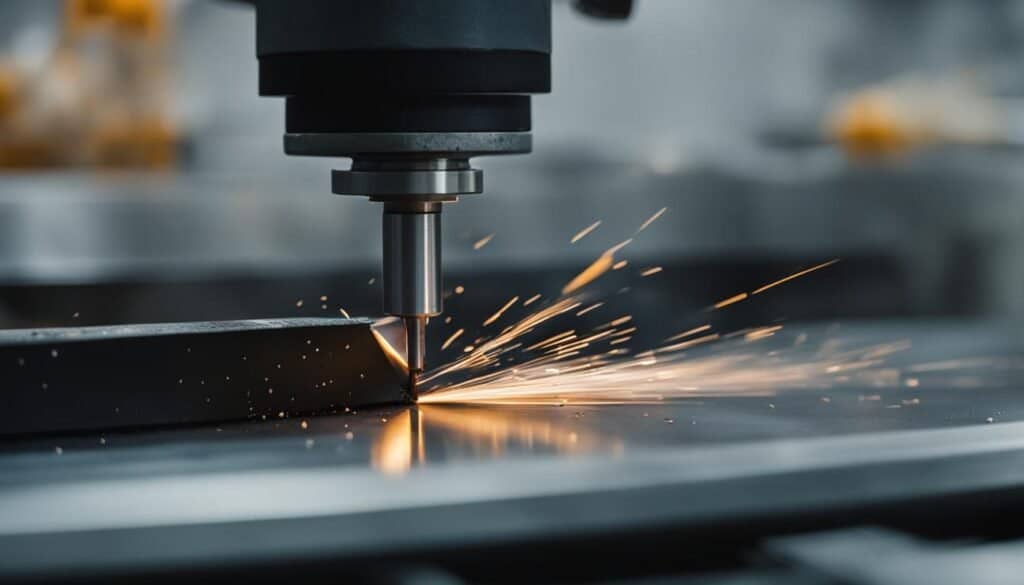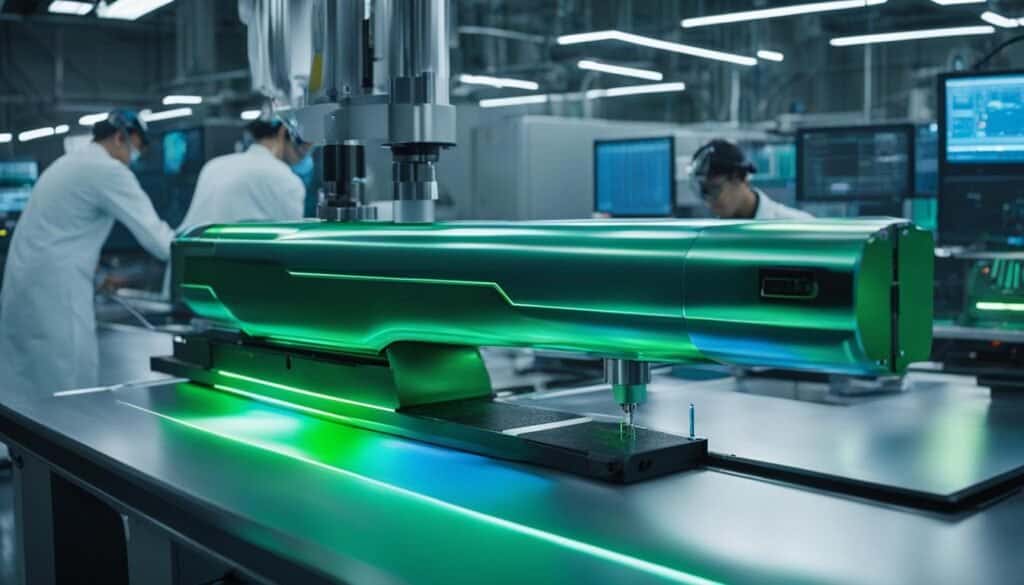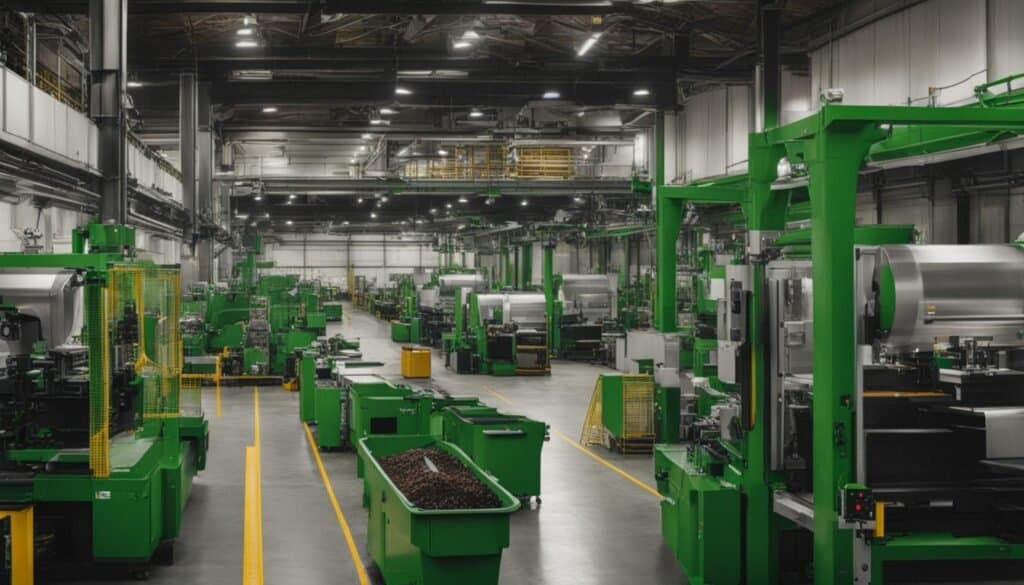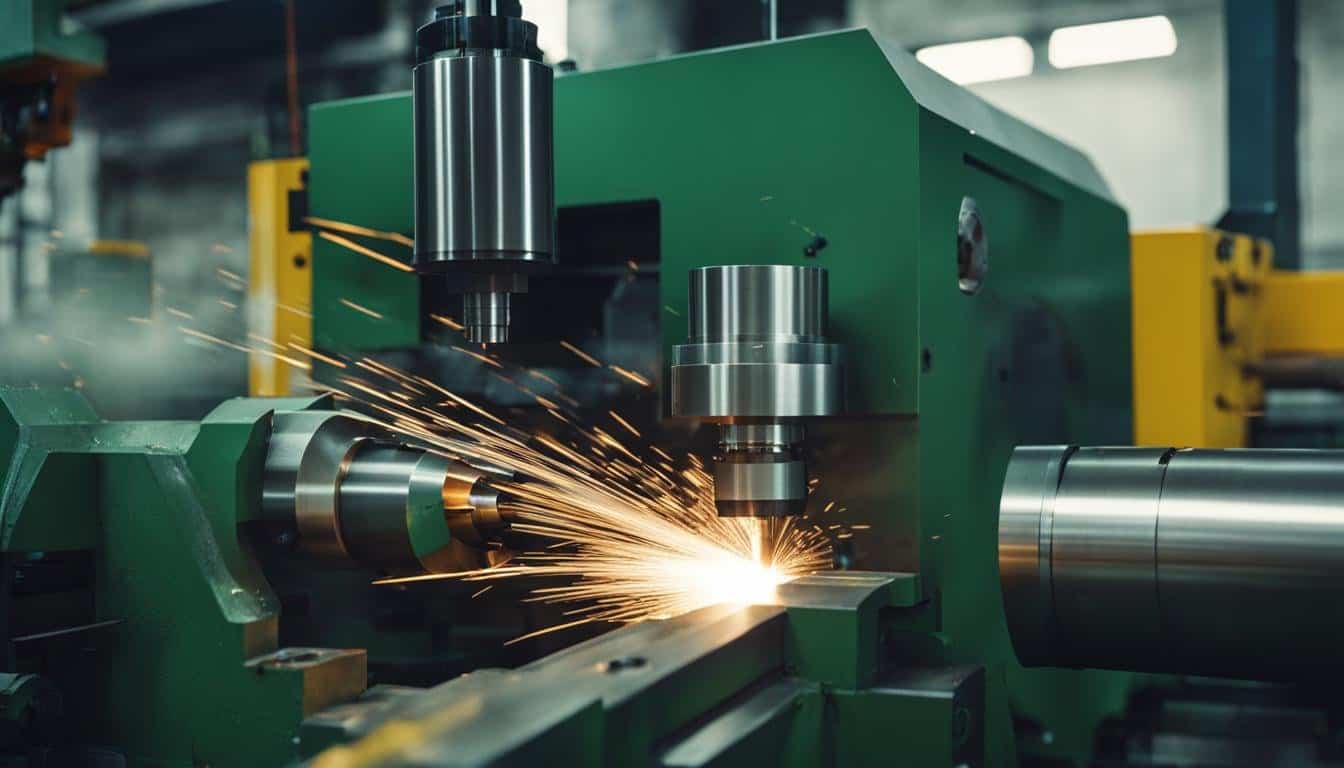Welcome to the world of green machining and tooling processes! As a responsible manufacturer, it’s important to adopt advanced techniques that prioritize both efficiency and environmental considerations. In this article, I will explore some of the latest manufacturing technologies offering sustainable and environmentally friendly machining solutions.
From precision cutting tools to CNC lathes, a growing number of industry players are turning towards green machining to produce ceramically machined components. While diamond tools may be more expensive, the investment can lead to greater longevity and improved efficiency in comparison to traditional tooling materials. With these innovative developments, it’s high time for manufacturers to embrace a more sustainable approach – for the betterment of both the environment and their bottom line.
Key Takeaways
- Green machining techniques minimize the use of harmful cutting fluids and generate less waste.
- Manufacturers can leverage advanced tools like CNC lathes to improve precision in greenmachining.
- Diamond tools, although pricier, offer enhanced efficiency and durability for environmentally friendly tooling processes.
- Sustainable manufacturing practices are becoming increasingly crucial in reducing the environmental impact of traditional machining processes.
- Future advancements in the industry will likely prioritize eco-friendly production methods and efficiency improvements.
Green Machining: A Shift Towards Sustainability in Manufacturing
The rise of sustainability in manufacturing has led to a significant shift towards green practices, including the adoption of green machining methods. This approach demonstrates the commitment of companies to environmental stewardship and promotes cleaner production techniques throughout the manufacturing process. With sustainable tooling practices, companies can minimize pollution and become industry leaders in environmentally responsible manufacturing.
Knowcnc.com advises that CNC machining has improved waste reduction through practices like optimizing material use, minimizing cut-off waste, and efficient part nesting techniques.
Green machining methods prioritize the implementation of green body features, which help to significantly reduce the usage of harmful cutting fluids and other polluting chemicals. Alongside these practices, the ongoing development of green machining technologies ensures that the manufacturing process becomes progressively more eco-friendly by focusing on resource conservation.
Some key advantages of green machining include:
- Reduced use of toxic substances in the manufacturing process
- Less pollution due to minimized waste generation
- Better resource utilization, leading to less material wastage
- Increased efficiency with sustainable and energy-saving processes
Aside from the environmental benefits of green machining, companies that employ these practices are well-positioned to align with regulations and societal expectations concerning responsible manufacturing. Implementing green machining processes also improve a company’s reputation as a proactive and forward-thinking industrial partner. As a result, businesses can attract environmentally conscious customers, investors, and partners who favor environmentally responsible organizations.
“Environmental sustainability is more than an ethical choice – it’s a smart business decision. By transitioning to green machining and production techniques, organizations demonstrate their commitment to responsible practices and create a competitive edge in the market.”
As the world continues to recognize the importance of sustainability for the well-being of both humans and the environment, manufacturers must embrace green practices and strageties. Green machining is a vital approach that benefits not only the industry, but also the planet.
Understanding the Environmental Impact of Traditional Machining Processes
Traditional machining processes often rely on extensive resource and energy consumption, resulting in a significant environmental footprint. In comparison, green machining aims to curtail resource use and energy expenditure by adopting more sustainable, efficient practices and by minimizing the reliance on cutting fluids and their associated health and environmental issues.
Comparing Resource and Energy Use in Conventional vs Green Machining
Differences in energy consumption and resource utilization between conventional machining and green machining can have a serious impact on the environment. To emphasize this contrast, consider the following table comparing various aspects of both practices:
| Aspect | Conventional Machining | Green Machining |
|---|---|---|
| Energy Consumption | Higher due to the use of high-energy processes and inefficient equipment | Lower due to the adoption of energy-saving technologies and more efficient processes |
| Resource Use | Higher, with resources such as raw materials, cutting fluids, and machine tools being consumed quickly | Lower, with an emphasis on resource conservation and improved material utilization |
| Waste Generation | High levels of waste produced from cutting fluids, tool wear, and scrapped material | Waste minimization through sustainable tooling, cleaner production techniques, and recycling initiatives |
| Environmental Impact | Higher levels of pollution from waste disposal, emissions, and inefficient energy use | Reduced environmental footprint through pollution prevention and efficient resource management |
As illustrated in the table, green machining methods can lead to significant resource conservation and energy savings, ultimately contributing to a cleaner, more sustainable approach to manufacturing.
The Role of Waste Minimization in Sustainable Tooling Practices
A cornerstone of sustainable tooling, waste minimization is instrumental in reducing environmental pollution and industrial waste. Effective resource management and a strategic move away from traditional practices to green machining techniques underscore waste minimization efforts. For example, properly managing waste streams, recycling cutting fluids, or utilizing more efficient machining processes can lead to substantial waste reduction.
“We cannot solve our problems with the same thinking we used when we created them.” – Albert Einstein
By adopting waste minimization strategies, manufacturers can not only alleviate environmental pollution and comply with stringent regulations but also enhance operational efficiency in the manufacturing process. This holistic approach to production ensures that businesses can achieve their sustainability goals while maintaining optimal productivity.
- Implement process optimization techniques to minimize waste generation during production
- Utilize advanced manufacturing technologies for improved resource and waste management
- Develop and adhere to environmentally responsible practices throughout the organization
Embracing sustainable tooling and waste minimization techniques is an essential element in the shift towards a greener, more efficient manufacturing landscape. By adopting these practices, manufacturers can significantly reduce their environmental impact while maintaining a competitive edge in their respective industries.
Advancements in CNC Lathes for Green Machining
The field of green machining has experienced significant growth due to advancements in CNC lathes. These cutting-edge machine tools have been integral in the
adoption of green machining practices that focus on environmentally conscious and sustainable manufacturing. By providing unrivaled precision engineering capabilities, CNC lathes have revolutionized lathe technology and machining innovations for industries worldwide.
There has been a significant shift towards automated manufacturing processes that prioritize sustainability, efficiency, and reduced environmental impact, thanks in part to the CNC advancements.
One of the key benefits of CNC lathes is their ability to offer precise control over the machining process, particularly for softer materials like green ceramics. This level of control is crucial in producing complex geometric features while maintaining high accuracy standards with minimal environmental impacts. This has led to a rise in green machining adoption within the manufacturing sector.
- Precision engineering enables the creation of intricate and complex parts.
- Lathe technology advancements improve the accuracy and repeatability of machining processes.
- Cutting-edge machine tools contribute to reduced energy consumption and waste during production.
- Automated manufacturing processes streamline production, increasing efficiency, and sustainability.
- CNC advancements enable customization and flexibility for a range of machining applications and materials.
| Traditional Machining | Green Machining with CNC Lathes |
|---|---|
| Higher resource and energy consumption | Reduced resource and energy usage |
| Increased pollution and waste generation | Environmentally friendly production methods |
| Limited precision and control for soft materials | Enhanced precision and control even for green ceramics |
| Manual labor and potential for human error | Automated processes all but eliminating human error |
In conclusion, the advancements in CNC lathes have considerably impacted the green machining sector by offering a sustainable and environmentally friendly approach to manufacturing. The precision engineering provided by modern CNC lathes has opened up new possibilities for industries seeking to adopt greener practices while maintaining high levels of accuracy, efficiency, and customization.
Key Parameters in Optimizing Green Machining of Ceramics

In the world of green machining, specifically for ceramics, certain factors are crucial to take into consideration. These factors include tool wear and material selection, as well as optimization of machining parameters like speed, feed rate, and surface quality control. Addressing these challenges will lead to improved manufacturing efficiency and precision for ceramic components.
Tool Wear and Material Selection: Diamond vs Tungsten Carbide Tools
One of the primary challenges in green machining ceramics is the abrasive nature of ceramic powders, which can accelerate tool wear. This necessitates careful material selection and choosing between two main options: diamond tools and tungsten carbide tools.
Although diamond tools come at a higher price, they offer greater longevity and a reduced frequency of tool changes. The investment in diamond tooling can therefore be justified through increased efficiency and precision.
In contrast, tungsten carbide tools are less expensive but may experience more rapid wear due to the abrasive ceramic powders. However, tungsten carbide tools still provide a viable option for budget-friendly green machining and can be cost-effective under certain conditions.
Machining Parameters: Speed, Feed Rate, and Surface Quality Control
Another critical aspect of optimizing green machining of ceramics is adjusting the machining parameters like speed, feed rate, and surface quality control.
A controlled approach is necessary due to the material’s low elastic modulus, which requires managing removal rates, debris production, and thermal effects on the part and tool bit. Adjusting lathe speeds, cutting angles, and pneumatic fixtures can help minimize damage and maintain dimensional accuracies for green machined ceramics.
- Feed Rate: Ideal feed rates for green machining are generally lower than those used in traditional machining to account for the material’s softness and avoid excessive force that could cause damage.
- Lathe Speeds: RPMs in green machining are often lower than conventional machining, and the correct speeds will depend on the specific ceramic material and tooling chosen. Proper speeds are essential for managing tool wear and controlling surface finish quality.
- Surface Quality Control: It is crucial to maintain surface quality during green machining, as it directly impacts the performance and service life of the machined part. Surface quality can be controlled by adjusting feed rates, lathe speeds, and cutting angles.
In conclusion, optimizing green machining of ceramics requires attention to tool wear, material selection, and the precise adjustment of machining parameters. By carefully considering these factors, manufacturers can successfully implement green machining techniques that yield high-quality ceramic parts with reduced environmental impact.
Advanced Coatings and Cutting Fluids Alternatives

In the realm of green machining, advanced coatings have proven significantly impactful in reducing the reliance on traditional cutting fluids. High hot hardness coatings such as TiN, TiAlN, AlTiN, and AlCrN contribute to increased high-temperature resilience and friction reduction at the tool-workpiece interface, minimizing tool wear and expanding tool life. Advancements in cutting fluids alternatives like dry and near-dry machining also play a vital role in boosting overall efficiency while reducing health and environmental impacts.
Exploring the Benefits of Dry and Near-Dry Machining
As sustainable manufacturing practices evolve, adopting dry and near-dry machining methods has become increasingly important for minimizing ecological footprints and conserving resources. These techniques offer several significant advantages over traditional cutting fluids, contributing to enhanced efficiency and eco-friendliness in machining operations.
- Tool wear reduction: Dry and near-dry methods lessen the friction and heat generation at the cutting edge, minimizing tool wear and prolonging tool life.
- Healthy and safe workplace: By avoiding the use of cutting fluids, these methods help reduce the exposure of workers to potentially harmful chemicals, creating a cleaner and safer work environment.
- Environmental protection: Reduction in cutting fluid consumption and disposal directly contributes to environmental conservation, supporting the goals of sustainable manufacturing.
- Economic benefits: Lower tool wear rate and reduced cutting fluid consumption translate into significant cost savings for manufacturers, making these machining processes more economically viable.
Additionally, the utilization of advanced high hot hardness coatings (TiN, TiAlN, AlTiN, and AlCrN) not only facilitates dry and near-dry machining but also enhances tool performance under high temperatures while supporting the quest for more sustainable machining processes.
| Coating Material | Key Properties | Application Range |
|---|---|---|
| TiN | High hardness, low friction | General cutting applications |
| TiAlN | High hot hardness, oxidation resistance | High-speed cutting, milling, drilling |
| AlTiN | Excellent wear resistance, thermal stability | Heavy-duty cutting, dry machining |
| AlCrN | High wear resistance, corrosion resistance, stability | Extreme cutting conditions, die and mold applications |
In conclusion, the adoption of advanced coatings and cutting fluids alternatives in conjunction with dry and near-dry machining techniques has significantly propelled forward the field of green machining. Embracing these innovations holds the potential to transform the manufacturing sector by aligning its practices with sustainable development goals and facilitating the transition to a cleaner, more efficient, and environmentally conscious production environment.
In The Loupe also recommends dry machining, which eliminates the costs and environmental issues associated with cutting fluid management and disposal.
Cold Isostatic Pressing (CIP): Enhancing Material Utilization
In the realm of green machining, the use of cold isostatic pressing (CIP) continues to rise in popularity due to its ability to enhance material utilization, improve dimensional control, and create near-net shapes. As a technique that serves both small and large volume parts, CIP is often followed by green machining for final shaping, creating components with impressive green density and strength ultimately important for achieving acceptable sintered density and microstructure.
- Producing near-net shapes with consistent green density and strength
- Minimizing deformation or cracking in sintered parts
- Improving material utilization by reducing waste
- Enabling careful control of powder filling and vibration for precision manufacturing
The combination of CIP and green machining affords manufacturers the opportunity to minimize waste and lower their environmental impact while maintaining high-quality finished products. By combining these techniques, manufacturing operations can enjoy significant cost and efficiency improvements, all while adhering to tighter sustainability targets and emerging industry standards.
“Cold isostatic pressing serves to create near-net shapes with enhanced green density and strength, ultimately vital for green machining and achieving a high-quality microstructure.”
It’s important for manufacturers to consider adopting CIP in their green machining processes, as it offers various benefits while facilitating a more sustainable, environmentally conscious production approach. Through the optimization of material utilization, dimensional control, and the creation of near-net shapes, CIP proves to be a valuable technique for any manufacturing operation looking to stay competitive while embracing greener practices.
High-Speed Machining and Its Contribution to Green Tooling

High-speed machining (HSM) is an advanced machining method that contributes significantly to green tooling by offering substantial energy savings and reduced environmental impact. The extreme cutting speeds associated with HSM minimize tool wear and maximize material removal rates, enhancing overall manufacturing efficiency. Integrating high-speed machining techniques enables companies to optimize productivity while simultaneously meeting their sustainability objectives.
Leveraging High Cutting Speeds for Energy Savings and Reduced Environmental Impact
High-speed machining is a powerful solution for companies looking to invest in new, efficient cutting techniques that improve sustainability. Harnessing HSM technology grants various benefits that are instrumental in promoting greener tooling processes. Some of the key advantages of high-speed machining include:
- Energy savings: By operating at high speeds, HSM allows for more rapid and efficient material removal, lowering the energy consumption by reducing the machining time needed to complete a job.
- Reduced tool wear: High cutting speeds reduce the rate of tool wear, thereby prolonging tool life and diminishing the demand for frequent tool replacements. This minimizes the waste generated in terms of worn-out cutting tools and the production of new ones.
- Improved surface finish: The increased cutting speeds of HSM result in a better quality surface finish than conventional methods, decreasing the need for time-consuming and energy-consuming post-machining processes like grinding or polishing.
- Optimized material removal: High-speed machining offers expedited material removal rates, enabling manufacturers to expedite production processes and operate more sustainably overall.
“High-speed machining is not only a powerful solution for increased productivity, but also a valuable ally in the quest for energy-efficient and environmentally friendly manufacturing.”
In conclusion, adopting high-speed machining techniques allows manufacturers to achieve a perfect balance between high performance and sustainable practices in the machining sector. By minimizing tool wear, reducing energy consumption, and enhancing overall efficiency, companies can reap the practical and ecological benefits of integrating HSM technology into their operations, fortifying their commitment to a greener future in manufacturing.
Integrating Sustainable Manufacturing Practices: Kaizen and 5S for Green Tooling

Integrating sustainable manufacturing practices such as Kaizen and 5S methodology into green tooling can be a game-changer in achieving both economic viability and eco-friendly manufacturing operations. By focusing on continuous improvement, efficiency enhancements, and waste reduction, these lean manufacturing principles support and optimize green tooling processes.
The Kaizen approach emphasizes incremental improvements to enhance overall productivity and resource utilization, contributing significantly to sustainable manufacturing goals. By identifying and eliminating waste, process optimization occurs, ultimately leading to more efficient and environmentally responsible green tooling operations.
Similarly, the 5S methodology provides a structured framework for workplace organization and standardization, facilitating seamless functioning and improved efficiency in green tooling processes. The 5S methodology consists of:
- Sort: Eliminate unnecessary items from the workplace
- Set in order: Arrange and label essential items for easy access
- Shine: Clean workspaces and equipment regularly
- Standardize: Establish routines for maintaining order and cleanliness
- Sustain: Continuously monitor, evaluate, and improve processes
Implementing Kaizen and 5S in green tooling operations effectively reduces production costs, minimizes waste, and enhances resource usage, paving the way for eco-friendly manufacturing practices.
“Sustainable manufacturing integrates practices like Kaizen and 5S, which emphasize continuous improvement, efficiency, and waste reduction. These methodologies transform green tooling processes by instilling structured workplace organization and a culture of incremental advancements, directly contributing to the eco-friendliness and economic viability of manufacturing operations.”
In conclusion, harnessing the power of Kaizen and 5S methodology in green tooling can significantly benefit both the environment and the manufacturing industry’s bottom line. By integrating these sustainable manufacturing practices into operations, businesses can optimize green tooling processes and contribute to a cleaner, more efficient manufacturing environment.
Conclusion on Manufacturing and Environmental Pollution
In the sustainable manufacturing future, it’s vital for organizations to adopt advanced machining methods and green tooling developments. Embracing innovative manufacturing solutions not only benefits businesses economically but also aligns them with the global push towards eco-friendly production. By utilizing strategic approaches and focusing on industry progression, companies can substantially reduce their ecological footprint and contribute to a greener, more sustainable world.
Green machining techniques and sustainable tooling practices have revolutionized the manufacturing sector by offering environmentally responsible options for creating high-quality products. The integration of cutting-edge technologies such as CNC lathes, advanced coatings, and High-Speed Machining (HSM) has demonstrated that precision and eco-conscious production go hand-in-hand. As businesses increasingly prioritize sustainability, manufacturers can capitalize on this momentum to foster a positive impact on their operations and the environment.
Efficiency and environmental stewardship are key aspects governing the future of manufacturing. As the industry progresses, it is becoming increasingly evident that businesses adopting green machining and tooling processes will enjoy a competitive edge. By deploying innovative manufacturing solutions, companies will continue to shape a resilient and responsible industry that caters to the evolving demands of customers, stakeholders, and the environment. The journey towards a more sustainable future starts now, and embracing green machining is an indispensable step towards achieving that goal.
FAQ on Green Machining and Tooling Processes
Q: What are the advantages of using ceramic tools in machining processes?
A: Ceramic tools offer high hardness, heat resistance, and wear resistance, which can result in improved machining efficiency and tool longevity.
Q: How does powder metallurgy relate to green machining?
A: Powder metallurgy is a key part of the green machining process as it involves the production of metal powders which are then used to form green compacts for machining.
Q: What role does lubrication play in green machining?
A: Lubrication is essential in green machining to reduce heat generation, minimize tool wear, and improve surface finish of the workpiece.
Q: How does surface roughness impact machining operations?
A: Surface roughness can affect the quality of machined components, influencing factors such as friction, wear, and overall performance of the parts.
Q: What are the main challenges in metal cutting using advanced ceramics?
A: Challenges include high cutting forces, thermal shock resistance, and the need for specific cutting parameters to optimize machining performance.
Q: How does green strength impact the machining process?
A: Green strength influences the dimensional stability of green compacts during machining, affecting the accuracy and integrity of the final machined components.
Q: What are the benefits of dry drilling in green machining?
A: Dry drilling eliminates the use of cutting fluids, reducing environmental impact and production costs, while improving the recyclability of powdered materials used in machining.
Q: What is the significance of the sintering process in green machining?
A: The sintering process is crucial to green machining as it involves the consolidation and densification of green compacts, resulting in the formation of solid metal or ceramic parts ready for final machining operations.
Q: How does the usage of cutting fluids impact the machinability of metal parts?
A: The proper application of cutting fluids can enhance tool life, reduce cutting forces, and improve surface finish during machining, leading to higher machinability of metal parts.
Q: What role does metal powder play in green machining techniques?
A: Metal powder serves as the starting material for green compacts, enabling the production of intricate and near-net shape components through green machining and subsequent processes.





Leave a Reply